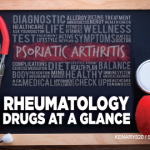The drugs most commonly prescribed/used by rheumatologists and rheumatology professionals in all reporting countries are listed below, as ranked on the list of top 50 drugs that may cause anaphylaxis:
3—Infliximab
7—Ibuprofen
9—Acetaminophen
10—Diclofenac
11—Adalimumab
12—Rituximab
13—Methotrexate
17—Etanercept
20—Naproxen
28—Aspirin
33—Celecoxib
40—Abatacept
47—Tocilizumab
49—Hydroxychloroquine
For anaphylaxis followed by death, the overall rate was rare, making up only 0.01% of total adverse event reports (17,506,002). The median age of patients reported to have had anaphylaxis followed by death was 60 years old, and 50% were women. The top drug classes for anaphylaxis followed by death were antibiotics (20.8%), radiocontrast agents (12.1%), intraoperative agents (11.9%), chemotherapy agents (9%) and monoclonal antibodies (5.7%). Fifty-six drugs were associated with 20 or more reports of anaphylaxis followed by death, and six drugs had more than 20% of their anaphylactic reactions lead to death. However, none of these six drugs is commonly used in rheumatology practice.
Of the top 20 drugs reported in association with general anaphylaxis, the seventh ranking drug, ibuprofen, had seven reported deaths from anaphylaxis in a total of 1,015 reported anaphylactic reactions. The study authors note that although many NSAIDs caused anaphylaxis, very few reactions were followed by death.
Monoclonal Antibodies
The researchers performed a linear regression for each major drug class associated with anaphylaxis. The linear regression for monoclonal antibodies showed an increasing slope over time, with the percentage of anaphylaxis reactions each year increasing faster than any other drug class evaluated, at an average rate of 0.77% of total FDA anaphylaxis reports, from 2% in 1999 to 17.4% in 2019. This may be due to the increased number and use of newer monoclonal antibodies for different indications in patient care.
Monoclonal antibody agents were five of the top 10 anaphylaxis-causing drugs reported in the U.S., accounting for 13,899 reports. The two monoclonal antibodies used in rheumatology were infliximab, accounting for 3.26% of reported anaphylactic events, and adalimumab, accounting for 2.4% of reported anaphylactic events. Naproxen and ibuprofen also made the top 10 list of anaphylaxis-causing drugs in the U.S., accounting for 1.73% and 1.7% of reported events, respectively.
Monoclonal antibody agents and disease-modifying anti-rheumatic drugs (DMARDs) accounted for five of the top 10 anaphylaxis-causing drugs reported to the FDA by Canada. The total number of anaphylaxis reports from Canada was 3,268, with 22.3% for methotrexate, 13.1% for adalimumab, 17.8% for etanercept, 15.4% for leflunomide, 14.8% for abatacept, 13.6% for rituximab, 13.1% for hydroxychloroquine, 12.9% for infliximab and 9.2% for tocilizumab.



